We've moved this content over from an older government website. We'll align this page with the ontario.ca style guide in future updates.
Procedures
The following chapter does not comprehensively specify all required measures and procedures for the Type 2 and Type 3 operations. For a complete list of requirements, please refer to the Regulation.
What section of the Regulation sets out the measures and procedures to be used when working with ACM?
As the risk to workers increases from Type 1 to Type 3 operations, the protective measures and procedures become increasingly stringent. The measures and procedures to be used in Type 1 operations are set out in section 14. Measures and procedures that are common to Type 2 and Type 3 operations are outlined in section 15. Section 16 sets out additional measures and procedures for Type 2 operations and section 17 deals with glove bag operations. Section 18 sets out the measures and procedures that, in combination with those found in section 15, are to be used in Type 3 operations.
How are the operational procedures broken down?
- Preparation of the work area
- Dust control
- Personal protective clothing and equipment, and
- Clean-up of the work area and waste removal
Checklists: See Appendix 3 for checklists of measures and procedures required for each type of operation. The checklists are intended to facilitate compliance with the requirements of the Regulation. They are not comprehensive and should not be exclusively relied upon to ensure compliance with regulatory requirements. For the comprehensive requirements, always refer to the Act and the Regulation.
Preparation of the work area
How should the work area(s) be prepared?
The following measures and procedures apply to Type 1, 2 and 3 operations:
- A wetting agent must be added to water used to control the spread of dust and fibres.
- Drop sheets must not be reused.
- Barriers and portable enclosures must not be reused unless they are rigid and can be cleaned thoroughly.
- Compressed air must not be used to clean up and remove dust from any surface.
- Eating, drinking, chewing or smoking must not be permitted in the work area.
Type 1 Operations
What are the procedures for conducting a Type 1 Operation?
When preparing for a Type 1 operation any visible dust must be removed from surfaces in the work area, including the thing to be worked on, if the dust is likely to be disturbed. The dust is to be removed either with a damp cloth or a vacuum
Type 2 Operations
What are the procedures for conducting Type 2 Operations?
Before beginning Type 2 operations the work area must be identified by clearly visible warning signs. A sufficient number of signs must be posted to warn of the hazard, they must state in large, clearly visible letters that there is an asbestos dust hazard, and that access to the work area is restricted to persons wearing protective clothing and equipment. Any crumbled, pulverized or powdered ACM that is likely to be disturbed and that is lying on any surface or object in the workplace must be cleaned up and removed. Friable ACM that is not crumbled, pulverized or powdered and that may be disturbed or removed during work, must be wetted and kept wet during the work unless wetting would create a hazard or cause damage.
If the Type 2 operation involves the removal of a false ceiling, it will not be possible to clean the upper surface of the ceiling tiles until at least one ceiling tile has been removed. In this case the friable ACM must be cleaned up and removed as soon as access to the work area, the area above the false ceiling, has been obtained. In some cases the ceiling tiles themselves may meet the definition of ACM, and must be removed and replaced in accordance with the requirements of the Regulation (paragraph 1 of section 16).
Where Type 2 operations involve the removal of all or part of a false ceiling to access the work area above the false ceiling, or the removal or disturbance of one square metre or less of friable ACM where the work is done indoors, the mechanical ventilation system serving the work area must be disabled, where practicable.
In the case of glove bag operations, the work area must be separated from the rest of the workplace by walls, barricades, fencing, or other suitable means. The mechanical ventilation system serving the work area must be disabled and all openings or voids, including ventilation ducts, must be sealed off to separate the work area from other parts of the workplace. Surfaces below the work area must be covered with drop sheets made of polyethylene or some other suitable material that is impervious to asbestos. The insulation jacketing or coating is to be inspected for damage or defects and repaired before the glove bag is attached. The glove bag must be inspected for damage or defects before it is attached to the pipe or duct and at regular intervals during its use.
Enclosures for Type 2 Operations
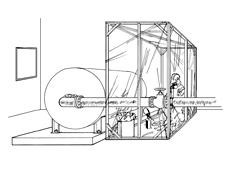
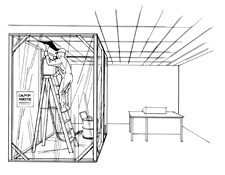
Source: Construction Safety Association of Ontario
Type 3 Operations
What are the procedures for conducting Type 3 Operations?
Type 3 operations are divided into work involving friable ACM and work involving non-friable ACM. The Regulation sets out measures and procedures for preparing the work area that are common to all Type 3 operations. In addition, the Regulation specifies additional procedures for operations involving work on friable ACM and for operations involving work on non-friable ACM. All Type 3 operations must be identified by signs that warn of the asbestos hazard. The signs must be posted in sufficient numbers to warn of the hazard and must also state, in large, clearly visible letters, that access to the work area is restricted to persons wearing protective clothing and equipment. The work area must be separated from the rest of the workplace by walls, the placing of barricades or fencing or other suitable means.
Where wet removal of asbestos is to be carried out, electrical safety is an important consideration. The use of wet methods increases the potential for electrical shock when working around electrical panels, conduits, light fixtures, junction boxes and other electrical items. Where practicable, existing electrical power distribution systems that are not watertight must be de-energized and locked out before work begins.
Where this is not practicable, it is recommended that dry removal methods be used in areas immediately adjacent to energized equipment.
If a temporary power system has to be set up to operate tools and equipment, it must be equipped with a ground fault circuit interrupter meeting the requirements of the Electrical Safety Authority (ESA).
Working with friable ACM
What are the preparation procedures for Type 3 Indoor Operations that are described in paragraphs 1, 2, 3, 4 and 6 of subsection 12(4)?
Before any of these operations are carried out indoors, friable ACM that is crumbled, pulverized or powdered and is lying on any surface in the work area, including furniture, flooring, equipment, machinery and so on, must be cleaned up and removed using a vacuum equipped with a HEPA filter or by damp wiping. Everything must be removed from the work area or covered with polyethylene sheeting or other suitable material that is impervious to asbestos. The ventilation system must be shut down and all vents, air ducts and other openings to or from the work area, sealed. This can be done with polyethylene or other impervious material, and duct tape. Polyurethane foam may be useful to seal areas that are difficult to tape.
Where the work area is not enclosed by walls it must be isolated by constructing an enclosure made of polyethylene or other suitable material to prevent the spread of dust from the work area. Even where the work area is enclosed by walls it may be advisable to line the walls and floors with polyethylene sheeting to facilitate the clean-up and to prevent damage to architectural finishes.
What are the requirements of the decontamination facility?
A decontamination facility must be built so that anyone entering or leaving the enclosed work area must pass through each room of the decontamination facility.
The decontamination facility must consist of at least three inter-connecting rooms:
- a clean room,
- a shower room, and
- an equipment room.
Two typical decontamination facilities are shown below. The doorways between rooms in the decontamination facility must be fitted with curtains of polyethylene or other suitable material on each side so that they will close behind workers as they pass through the doorways. This is to minimize the spread of asbestos fibres from the work area.
Decontamination facilities
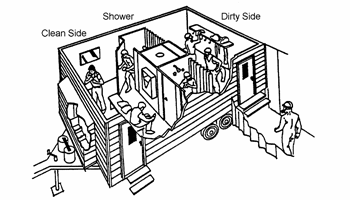
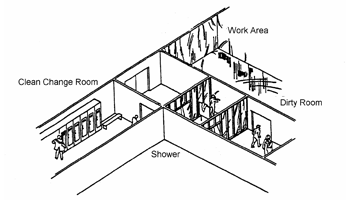
Source: Construction Safety Association of Ontario
Clean room: This room is to be used for changing into uncontaminated protective clothing, putting on respiratory equipment, storing clean clothing and, after showering, for dressing in street clothes. No asbestos-contaminated items are allowed in this room. The clean room could be furnished with benches, lockers for clothes and valuables, and suitable storage for respirators.
Shower room: The shower room should be located between the clean room and the equipment room. This will ensure that workers leaving the contaminated equipment room must pass through the shower room in order to enter the clean room. A temporary shower can be installed using prefabricated shower stalls with catch pans and sump pumps. Hot and cold water supplies should be available nearby in most buildings. For hot water lines, it is recommended that high quality rubber hose be used to prevent bursting and leakage. The shower must be supplied with both hot and cold water or with warm water of a constant temperature between 40° and 50° Celsius. The shower must have individual controls to regulate the water flow and, if there is hot and cold water, to regulate the temperature.
It is recommended that there be sufficient showers to avoid delays. Having to wait for access to a shower could cause some individuals to rush through the decontamination procedure or to skip it altogether. The shower room must also be equipped with clean towels.
Equipment room: Contaminated work clothes, footwear, hard hats, goggles and other equipment should be stored in an area adjacent to the shower room. This area is also to be used for workers to remove contaminated clothing prior to entering the shower.
The rooms should be arranged so that any person passing through the work area must pass through each room and must:
- decontaminate his or her protective clothing using the vacuum or damp wiping;
- remove his or her protective clothing;
- place the protective clothing in the prescribed container;
- shower; and,
- remove and clean the respirator.
Waste removal: Although not required by the Regulation, it may be desirable to construct a waste load-out area to transfer asbestos-containing waste from the work area for eventual disposal at a landfill. The waste load-out area consists of a room built into the enclosure, but separated by airlocks from the work area and the area outside the enclosure as shown below.
Curtained doorways made from overlapping sheets of polyethylene or other impervious materials are used to form the air locks. Waste containers are cleaned by damp wiping or use of a HEPA vacuum in the work area and then placed in the waste load-out area. When a load has accumulated, the room can be sealed off from the work area and the waste transferred to a truck for transport to a landfill.
Example of a waste load out area
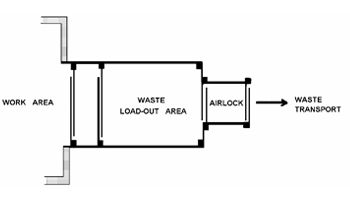
The disposal of asbestos waste is governed by Regulation 347, General—Waste Management, made under the Environmental Protection Act.
What are the procedures for working with ACM for Type 3 Operations Outdoors that are described in paragraphs 1, 2, 3, 4 of subsection 12(4)?
Where Type 3 operations involving friable ACM are carried on outdoors, enclosures are not required and the work area must be separated from the surrounding area by barricades, fencing or other means (see below). Steps must be taken to ensure that dust and waste cannot fall freely from one level to another. This may include the use of drop sheets made of polyethylene or other material that is impervious to asbestos on work surfaces. Care should be taken to ensure that the material used does not create a slipping hazard that may put workers at risk of falling.
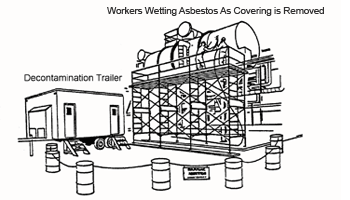
Source: Construction Safety Association of Ontario
Construction of a decontamination facility: A decontamination facility must be located as close as practicable to the work area. The decontamination facility must consist of a room suitable for changing into protective clothing and for storing contaminated protective clothing and equipment; a shower room; and a room suitable for changing into street clothes and for storing clean clothes and equipment. The decontamination facility must be constructed so that any one entering or leaving the work area must pass through each room. Customized trailers outfitted with three room decontamination facilities are available for use as decontamination facilities. These units can be moved from one work site to the next and are commonly used for outdoor work.
What are the procedures when working with Non-Friable ACM described in paragraph 5 of subsection 12(4)?
Operations involving non-friable ACM include cutting of transited pipe, removal of asbestos-containing ceiling texture, plaster, drywall compound and roofing materials. For work on non-friable ACM that is done with power tools that are not attached to dust-collecting devices equipped with HEPA filters, an enclosure of polyethylene or other suitable material must be constructed, unless walls already enclose the work area. The entrances and exits to the enclosure must be fitted with curtains made of polyethylene or other suitable material that is impervious to asbestos, on each side (see below) and, if the enclosure is opaque, it must be fitted with one or more transparent windows to allow observation of the entire work area from outside the enclosure. These requirements apply whether the work is done indoors or outdoors. The construction of an enclosure is discussed in the previous section dealing with preparation for indoor Type 3 operations involving ACM that are described in paragraphs 1, 2, 3, 4 and 6 of subsection 12(4).
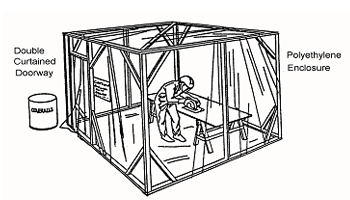
Source: Construction Safety Association of Ontario
Dust control
There are three aspects to the control of asbestos dust:
- control at the source
- separation between the worker and the source, and
- hygiene measures and procedures
Control at the source
Wetting, the use of drop sheets or enclosures, local exhaust ventilation and the maintenance of negative air pressure within enclosures are some of the measures and procedures used to prevent the spread of asbestos dust by control at the source.
Wetting: Keeping ACM wet tends to reduce the number of asbestos fibres that get into the air and also increases the settling rate of the fibres that are released. The Regulation requires that a wetting agent be added to water that is used to control the spread of dust and fibres.
The use of drop sheets and enclosures: Drop sheets made of polyethylene or other suitable material that is impervious to asbestos can be used in Type 1 operations or in some Type 2 operations to prevent the spread of dust from the work area. Enclosures made of polyethylene or other material that is impervious to asbestos must be used on some Type 2 and Type 3 operations to stop the spread of dust from the work area if the work area is not enclosed by walls.
Use of local exhaust ventilation: In most indoor Type 3 operations, the generation of airborne asbestos fibres must also be controlled by installing a ventilation system equipped with HEPA filters and by establishing and maintaining a negative air pressure of 0.02 inches of water.
Maintenance of negative air pressure: The maintenance of negative air pressure within the enclosure relative to the area outside the enclosure helps to prevent the spread of fibres and is a requirement for indoor Type 3 operations. Since the negative air unit exhausts air from the enclosure through a HEPA filter, it also helps to reduce airborne asbestos concentrations within the enclosure. Negative air is also required for some indoor Type 3 operations involving friable materials.
What are the requirements of the ventilation system?
A ventilation system equipped with a HEPA filtered exhaust unit must be installed inside the enclosure required for all indoor Type 3 operations. This system must be used to create and maintain a negative air pressure of 0.02 inches of water relative to the area outside the enclosure. The negative air requirement is not required for situations where a building will be demolished and will only be entered by workers involved in the asbestos operation and by demolition workers. The replacement air and air pressure must be checked at regular intervals to ensure there are no leaks.
HEPA-filtered negative air unit
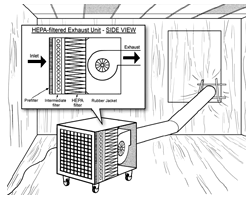
Source: Construction Safety Association of Ontario
For Type 1 Operations
When a Type 1 operation involves the removal of less than one square metre of drywall in which ACM joint-filling compound has been used, the material must be wetted and kept wet during the work, unless wetting would create a hazard or cause damage.
Breaking, cutting, drilling, abrading, grinding, sanding or vibrating non-friable ACM can only be classified as a Type 1 operation if the material is wetted or if the work is done by means of non-powered hand-held tools. In all Type 1 operations, the spread of dust from the work area must be controlled by the use of drop sheets of polyethylene or other suitable material, or by other measures specified in section 14 of the Regulation.
For Type 2 Operations
Friable ACM that is not crumbled, pulverized or powdered and that may be disturbed or removed during the work must be thoroughly wetted before the work begins and must be kept wet during the work. The only exception is when wetting would create a hazard or cause damage.
In Type 2 operations involving the removal of all or part of a false ceiling where ACM is likely to be on the surface of the ceiling and the removal or disturbance of one square metre or less of friable ACM, the mechanical ventilation system serving the work area must be disabled and all openings or voids, including ventilation ducts, must be sealed. This will help to prevent the spread of asbestos fibres outside the work area.
Where appropriate, the spread of dust must be controlled by measures appropriate to the work, including the use of drop sheets or other suitable material made of material that is impervious to asbestos
In the case of Type 2 operations involving work above a false ceiling or work involving the removal or disturbance of one square metre or less of friable ACM, the work area must also be surrounded by an enclosure made of polyethylene or other suitable material impervious to asbestos, where practicable. Unless the enclosure is made of transparent material it must be equipped with a window or windows that will allow anyone to view the entire enclosure from the outside. Glove bags serve to control asbestos dust and waste at the source by containing the wetted ACM during the removal and by containing the waste. Surfaces below a glove bag operation must also be covered with a drop sheet.
Worker wetting ACM
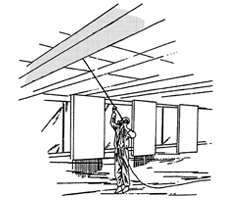
Source: Construction Safety Association of Ontario
For Type 3 Operations
The Regulation requires that, before ACM is removed indoors, the work area must be enclosed and a decontamination facility set up, as described previously. This applies to all indoor Type 3 operations, including when the operation described in paragraph 5 of subsection 12(4) is carried on indoors. The friable ACM must be thoroughly wetted and kept wet throughout the removal, unless this would create a hazard or cause damage. Dust and waste must also be kept wet if practicable.
The Regulation requires that a competent worker inspect the work area at the start of each shift, at the end of each shift, unless the next shift starts immediately, and at least once on days when there are no shifts. The purpose of the inspection is to find any defects such as tears or damaged seams in the enclosure, the barriers, and the decontamination facility.
In some Type 3 operations, unless the building will be demolished and will only be entered by asbestos abatement and demolition workers, the spread of dust from the work area must be prevented by maintaining a negative air pressure of 0.02 inches of water relative to the area outside the work area. For some Type 3 operations, subsections 18 (2) paragraph 2 and 18 (4) paragraph 5 require that a ventilation system equipped with a HEPA filtered exhaust unit be used to create and maintain the specified negative air pressure. The pressure difference must be measured frequently and at regular intervals and the ventilation system used to maintain the negative air pressure must be inspected and maintained by a competent worker before each use. Replacement air taken from outside the enclosed area must not be contaminated with any hazardous dust, vapour, smoke fume, mist or gas. The purpose of the inspection and maintenance requirement is to ensure that there is no air leakage, either through the filters or around any part of the equipment. If, during the course of the inspection, the filter is found to be damaged or defective, it must be replaced before the ventilation system is used.
The ventilation system that is used to maintain the enclosed area at negative pressure must be inspected and maintained regularly by a "competent worker" before each use.
The use of negative air pressure offers several advantages. If the enclosure is torn, air will leak into, rather than out of the work area. This minimizes the risk of asbestos contamination outside of the enclosure. The concentration of airborne fibres in the work area will be reduced as contaminated air is filtered and exhausted. The circulation of fresh air through the work area may help to control temperature and relative humidity inside the enclosure, possibly improving worker comfort and reducing the risk of excessive exposure to heat inside the enclosure.
In all Type 3 operations the work area must be separated from the rest of the workplace by barriers, fences, or other suitable means. In outdoor Type 3 operations described in paragraphs 1, 2, 3, and 4 of subsection 12(4) of the Regulation, any ACM that is to be removed must be wetted, if practicable, and kept wet during the removal. Dust and waste must not be allowed to fall from one level to another. For example, it may be necessary to cover or enclose scaffolding to ensure that material cannot fall down to lower levels.
Type 3 operations that are done on non-friable ACM using power tools that are not attached to a dust-collector equipped with a HEPA filter must be done in enclosures, unless the work area is enclosed by walls. The requirement for an enclosure applies whether the work is done indoors or outdoors (subsection 18(2)). If the enclosure is made of non-transparent material, one or more transparent windows must be added to the enclosure so that the entire work area can be seen from outside the enclosure. The windows can be constructed of break resistant plastic set in wooden frames and incorporated into the framework of the enclosure. Entrances and exits to the work area must be fitted with plastic sheets on each side.
If the work is done indoors in a building that will not be demolished, the area inside the enclosure must be kept at a negative air pressure of 0.02 inches of water relative to the area outside the enclosure. The equipment used to maintain the negative pressure must be inspected before and during the work and testing must be done to ensure that the pressure difference is maintained during the work.
If the work is done outdoors or inside a building that will be demolished, and that will only be entered by asbestos abatement and demolition workers, the maintenance of negative air pressure is not required.
Separation between the worker and the source
The use of barriers, fences, enclosures and glove bags helps to control asbestos exposure by separating workers from the source of asbestos dust and fibres. Restricting access to the work area keeps persons not involved in the work from being exposed to asbestos or spreading fibres outside the work area. The requirement for clearance air testing at the end of indoor Type 3 operations involving the removal of ACM that is described in paragraphs 1, 2, 3, 4, and 6 of subsection 12(4) ensures that workers who enter the area following the removal are not exposed to asbestos fibres.
For Type 1 Operations
Type 1 operations require controlling the spread of dust through appropriate measures including the use of drop sheets that are impervious to asbestos. Depending upon the nature of the work, barriers and portable enclosures may also be used. Although it is not a regulatory requirement, it is recommended that workers who are not carrying out the Type 1 operation be excluded from the work area until the work has been finished and the area cleaned up and all dust and waste removed.
For Type 2 Operations
Signs warning of an asbestos hazard must be clearly visible for all Type 2 operations and access must be restricted to workers who are wearing protective clothing and equipment. It is recommended that barriers and portable enclosures be used to separate the work area from other areas.
Ventilation requirements specified in paragraphs 1 and 2 of subsection 12(3) help to ensure that workers in other parts of the workplace are not exposed to asbestos. In addition, the Regulation also requires a polyethylene enclosure if the work area is not enclosed by walls and the operation is being carried on indoors.
Certain types of Type 2 operations specified in paragraphs 1 and 2 of section 12(3) require a polyethylene enclosure if the work area is not enclosed by walls and the operation is being carried on indoors.
The use of glove bags for the removal of friable ACM serves to protect both the workers involved in the operation and other workers by separation from the source of potential exposure to asbestos.
Work areas where Type 2 glove bag operations are being carried out must be separated from the rest of the workplace by walls, barricades, fencing or some other suitable warning means.
For Type 3 Operations
Work areas where Type 3 operations are being done must have clearly visible warning signs and access restricted to workers wearing protective clothing and equipment. The work area must be separated from the rest of the workplace by walls, barricades, fencing, or other means that are suitable in the circumstances.
Indoor Type 3 operations mentioned in subsection 18(4) require the use of a polyethylene or other suitable enclosure unless walls enclose the work area. Negative air pressure must be maintained inside the enclosure unless the building will be demolished and will only be entered by workers involved in the removal or by demolition workers. For Type 3 operations involving ACM described in paragraphs 1, 2, 3, 4, and 6 of subsection 12(4) a decontamination facility is required. Inspection and maintenance of the negative air unit, regular measurement of the negative air pressure, and regular inspections of the work area (specifically the enclosure, barriers and decontamination facility) are regulatory requirements that help to reduce airborne asbestos fibre concentrations inside the enclosure.
All Type 3 operations require separation between the work area and the rest of the workplace using walls, barricades, fencing or other suitable means. On many outdoor projects fencing or barricades will be sufficient to keep unprotected workers well away from the work area, and the use of wet methods and washing the area after the removal will help to prevent the spread of dust and fibres. In the case of a multilevel work area in an outdoor Type 3 operation described in paragraphs 1, 2, 3, and 4 of subsection 12(4), such as a removal on the side of a building that requires the use of scaffolding, the different work levels must be separated so that dust and waste will not fall freely from one level to another.
As previously discussed, all Type 3 operations where non-friable ACM is broken, cut, drilled, abraded, ground, sanded, or vibrated using power tools not attached to HEPA filtered dust-collectors require the use of a polyethylene or other suitable enclosure. If the work is done outdoors or if it is done in a building that will be demolished and will only be entered by the workers doing the asbestos removal or by workers involved in the demolition, then negative air pressure does not have to be maintained inside the enclosure. If the work is done in a building that will not be demolished or that will be entered by other workers prior to demolition then the enclosure must be kept at negative air pressure relative to the area outside the enclosure.
Hygiene measures and procedures
The Regulation also prescribes hygiene practices and procedures to protect workers, including washing or shower facilities, decontamination of personal protective clothing and equipment, the prohibition of eating, drinking, chewing and smoking, and the strict separation of clean and contaminated clothing and equipment.
For Type 1 Operations: Facilities for washing the hands and face must be provided for workers and the workers must use them when leaving the work area.
For Type 2 Operations: The worker must decontaminate protective clothing and barriers and enclosures using a HEPA vacuum or damp wiping before removing the clothing and leaving the work area. Facilities for washing the face and hands must be provided and every worker must use these facilities as they leave the work area.
For Type 3 Operations: Workers who are carrying out Type 3 operations described in paragraphs 1, 2, 3, 4 and 6 of subsection 12(4) must pass through a decontamination facility as they leave the work area. The decontamination facility, which must consist of a room for changing into protective clothing and equipment and for storing contaminated clothing and equipment, a shower room, and a room for storing clean clothing and equipment and changing into street clothes, is described in detail in the first section of this Chapter. If the work is done outdoors the decontamination facility must be set up as close as practicable to the work area. If the work is done indoors the decontamination facility must be located so that the workers must go through it to enter and leave the work area. However, in some circumstances it may be necessary for the employer to use the provisions of section 23 to vary the methods and procedures set out in the Regulation to set up a remote decontamination facility. This is often necessary in facilities like electric generating stations where the physical layout of the work area may not accommodate a decontamination facility.
Where a decontamination facility has been provided, the following procedure must be followed by every person leaving the work area. All protective clothing (coveralls, boots and head covering) and all protective equipment (hardhat, safety goggles) except the respirator is removed in the equipment room. The worker then enters the shower, rinses the face piece of the respirator and then removes the respirator.
If a powered air purifying respirator is worn, it is recommended that you take steps to keep the filters dry and the filter unit and power pack should be wet wiped rather than placed under the shower. It is also recommended that non-powered respirators be thoroughly washed and, in the case of a filter respirator, the filter cartridges soaked in the shower and disposed of on the dirty side of the shower. The worker then exits the shower from the clean side, with the respirator, and dons street clothes or a new set of coveralls that are stored in the clean room.
Workers who are carrying out Type 3 operations must decontaminate their protective clothing and equipment using damp wiping or a HEPA vacuum before removing it and leaving the work area. Facilities for washing the hands and face must be provided and every worker must use these facilities when leaving the work area.
Personal protective clothing and equipment
The personal protective clothing and equipment required by the Regulation consists of respirators, to control the exposure of workers in the work area, and protective clothing, to protect workers from secondary exposures and to prevent workers from transporting asbestos from the work area. To be effective, respirators and protective clothing must be selected and used, cleaned and removed correctly.
Respirators
For more information on respirators see Respirators.
Respirators approved by the National Institute for Occupational Safety and Health (NIOSH) may be used in Type 1 operations if the worker requests them and are required for Type 2 and Type 3 operations. Table 2 of the Regulation (see Respirators) summarizes the respirator requirements for Type 1, Type 2, and Type 3 operations.
Protective clothing
Protective clothing must be provided by the employer to all workers who work on Type 2 or Type 3 operations and to workers involved in a Type 1 operation if requested by the worker. The requirements for protective clothing are set out in paragraph 12 of section 15 of the Regulation. It must:
- be made of material that does not retain or permit the penetration of asbestos fibres,
- include suitable footwear and a head covering, and
- include a full body covering that fits snugly at the wrists, ankles and neck.
Disposable coveralls that meet these requirements are available and are widely used in asbestos work. They can be easily torn, however, and must be repaired or replaced when this happens. The choice of suitable footwear is dependent on the type of work. High top rubber boots are ideal for wet removal work, and are available as safety footwear. Conventional safety boots or safety shoes may be more appropriate for other types of work. The head covering may be a hood attached to coveralls or a separate cap. If the job requires a hardhat, it should be worn over the head covering.
Once the work area has been entered, a worker must not leave it without decontaminating the protective clothing. This must be done with a vacuum equipped with a HEPA filter or by damp wiping. Protective clothing, once contaminated, must not be worn outside the work area. Protective clothing that will not be reused must be placed in the type of container prescribed in paragraph 5 of section 15.
Clean-up of the work area and waste removal
Cleanup of the work area continues throughout the operation beginning shortly after the start of work. For all types of operations the Regulation requires that all dust and waste are to be cleaned up and removed at frequent and regular intervals as the work proceeds and immediately upon completion of work. This must be done with a vacuum equipped with a HEPA filter or by damp mopping or wet sweeping. Compressed air must never be used to remove dust from any surface.
Containers for dust and waste must be:
- Dust tight
- Suitable for the type of waste
- Impervious to asbestos
- Identified as asbestos waste
- Cleaned with a damp cloth or vacuum equipped with a HEPA filter before being removed from the work area.
In addition to the prescribed requirements for asbestos waste containers, you may wish to consider the following:
Plastic bags with appropriate labels are commercially available. It is advisable that plastic bags be placed in large fibre drums for transport. Large bins can be lined with material that is impervious to asbestos and used to transport waste that is heavy or would tear bags.
The disposal of asbestos waste is covered by Regulation 347, General—Waste Management, made under the Environmental Protection Act. Asbestos waste must be handled by an appropriately licensed waste hauler and the disposal site should be notified prior to delivery of the waste so that necessary preparations can be made to receive the material. For clarification of waste disposal requirements under this Regulation, please contact the local office of the Ministry of the Environment.
Polyethylene sheeting and similar materials used for drop sheets and enclosures must not be reused. When the work is complete they must be wetted and placed in an asbestos waste container as prescribed by the Regulation.
Barriers and portable enclosures must not be reused unless they are rigid and can be thoroughly cleaned. The cleaning must be done by damp wiping or using a HEPA vacuum. In Type 2 and 3 operations, this cleaning must be done after paragraphs 6 and 8 of section 15 have been complied with. These paragraphs address the cleanup of dust and waste and the wetting and disposal of polyethylene and similar sheeting.
If, during a Type 2 glove bag operation, the glove bag is found to be damaged or defective the use of the glove bag must be discontinued. In addition, the inside of the bag and its contents must be wetted and discarded in an appropriate asbestos waste container. The work area must also be cleaned with a vacuum equipped with a HEPA filter before work is resumed.
The final clean-up and clearance air testing is the most critical phase of Type 3 operations involving ACM that are done indoors and described in paragraphs 1, 2, 3, 4 and 6 of subsection 12(4). If not done properly, future occupants of the building may be exposed to hazardous levels of airborne asbestos fibres. The procedures for clearance air testing are prescribed in subsections 18(5) to 18(9). Subsection 18(4) paragraph 5 of the Regulation requires that the enclosed area must be kept at a negative pressure of 0.02 inches of water relative to the area outside the enclosure.
It is recommended that surfaces from which asbestos insulation has been removed should be brushed to loosen any remaining material and wiped or vacuumed clean. A water-based sealant can be applied to encapsulate any fibres that remain. The work area, the inner surface of the enclosure, and the tools and equipment must be cleaned by a thorough washing or by vacuuming with a vacuum equipped with a HEPA filter and a visual inspection done. Equipment, tools and other items must be cleaned by damp wiping or using a HEPA vacuum and placed in a container suitable for holding asbestos waste before being removed from the work area.
A competent worker must then inspect the work area and the enclosure to ensure that all visible dust, debris or residue that may contain asbestos has been removed. The purpose of the visual inspection is to ensure that any visible dust or debris or residue that might contain asbestos has been removed. The American Society for Testing and Materials (ASTM) Standard E 1368--05 Standard Practice for Visual Inspection of Asbestos Abatement Projects can be used as guidance for carrying out a visual inspection.
Once the work area has dried, a competent worker must carry out clearance air testing, unless the work has been done in a building that will be demolished and will only be entered by workers involved in the asbestos abatement or by demolition workers.
In the circumstances in which clearance air testing is required, the barriers, enclosure and decontamination facility must not be dismantled until the work area has passed the clearance air test.
In those circumstances in which clearance air testing is not required, the barriers, enclosures and the decontamination facility must not be dismantled until they have been cleaned as prescribed in paragraph 15 of subsection 18(4).
Upon passing the clearance air test or completing paragraph 15 of subsection 18(4) the enclosure and decontamination facility can then be dismantled.
Polyethylene or other similar sheeting used to construct the enclosure must be wetted and disposed of as asbestos waste in the prescribed container.
Where a Type 3 operation involving ACM described in paragraphs 1, 2, 3 and 4 of subsection 12(4) has been done outdoors, the work area is to be washed down after the job is completed, unless it is not practicable to do so after the cleanup and removal of dust and waste described in paragraph 6 of Section 15.
Footnotes
- footnote[1] Back to paragraph Whenever dust or debris that might contain asbestos is to be vacuumed, the Regulation requires the vacuum to be equipped with a HEPA filter. Use of a vacuum that is not so equipped may result in hazardous levels of airborne asbestos because ordinary vacuum filters are unable to remove small asbestos fibres, and as a result, these fibres are blown into the air through the vacuum exhaust outlet.
- footnote[2] Back to paragraph It is important to note the different meanings of the terms "practicable" and "practical". The Regulation requires the disabling of the ventilation system and the erection of an enclosure, where practicable. "Practicable" means possible. What the Regulation is saying, then, is that if it can be done then it must be done. But being able to do something does not make it useful in practice. While it may be practicable to shut down the ventilation system in a building in order to work in one small area of it, it may not be practical to do so, at least while the building is occupied. If there is no practicable way to comply with the Regulation, it may be necessary to use the provisions of section 23 to vary the measures and procedures used during the work. In this case the varied measures and procedures must provide protection to the worker that is equal to the protection that would be provided by following the measures and procedures set out in the Regulation.